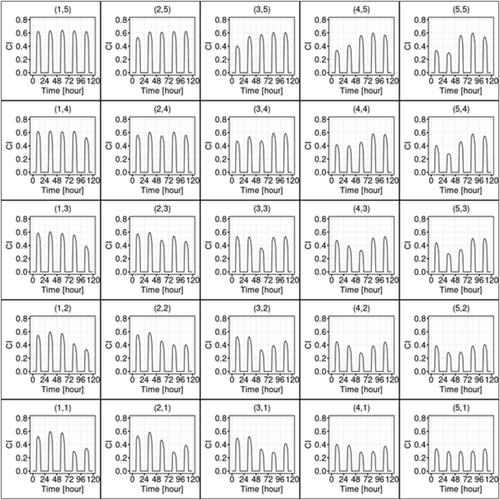当前位置:
X-MOL 学术
›
Meteorol. Appl.
›
论文详情
Our official English website, www.x-mol.net, welcomes your
feedback! (Note: you will need to create a separate account there.)
Assessment of characteristics of surface solar irradiance on consecutive days using a self‐organizing map and clustering methods
Meteorological Applications ( IF 2.3 ) Pub Date : 2021-03-30 , DOI: 10.1002/met.1984 Takeshi Watanabe 1 , Kazutaka Oka 1 , Yasuaki Hijioka 1
Meteorological Applications ( IF 2.3 ) Pub Date : 2021-03-30 , DOI: 10.1002/met.1984 Takeshi Watanabe 1 , Kazutaka Oka 1 , Yasuaki Hijioka 1
Affiliation

|
The assessment of surface solar irradiance as a resource is a major research topic in renewable energy. A method for assessing the characteristics of global horizontal solar irradiance (GHI) at the surface on consecutive days is proposed in this work. A self‐organizing map and cluster analysis are used as core analysis techniques in the proposed method. Using this method, the regional and seasonal characteristics of GHI for five consecutive days are analysed. One hour accumulated GHI data from ground observation stations in Japan are used. Time series assigned to each node on the topological map of the self‐organizing map are characterized by strength and variability. The probabilities of occurrence of each node on the map differ between stations. Then, using the probabilities as a feature vector for quantifying the characteristics of each observation station, a cluster analysis is conducted to divide stations into clusters according to the dissimilarity of the features. The results show that there are three major regions in which the station characteristics are similar in Japan. Additionally, another cluster analysis is conducted to investigate the seasonal characteristics of the occurrence of time series patterns. It is found that consecutive cloudy days occur frequently in winter and during the rainy season, whereas consecutive clear days occur frequently in spring and summer.
中文翻译:

使用自组织图和聚类方法评估连续几天的表面太阳辐照度特征
作为一种资源,对表面太阳辐照度的评估是可再生能源的主要研究课题。在这项工作中,提出了一种评估连续几天地表全球水平太阳辐照度(GHI)特性的方法。该方法将自组织图和聚类分析用作核心分析技术。使用这种方法,分析了连续五天GHI的区域和季节特征。使用了日本地面观测站累积的一小时GHI数据。分配给自组织图的拓扑图上的每个节点的时间序列以强度和可变性为特征。站点上地图上每个节点的出现概率不同。然后,使用概率作为量化每个观测站特征的特征向量,进行聚类分析,根据特征的不相似性将观测站划分为聚类。结果表明,在日本有三个主要站点的站点特征相似。此外,还进行了另一类聚类分析,以研究时间序列模式发生的季节特征。发现在冬季和雨季频繁出现连续阴天,而在春季和夏季频繁出现连续阴天。结果表明,在日本有三个主要站点的站点特征相似。此外,还进行了另一类聚类分析,以研究时间序列模式发生的季节特征。发现在冬季和雨季频繁出现连续阴天,而在春季和夏季频繁出现连续阴天。结果表明,在日本有三个主要站点的站点特征相似。此外,还进行了另一类聚类分析,以研究时间序列模式出现的季节特征。发现在冬季和雨季频繁出现连续阴天,而在春季和夏季频繁出现连续阴天。
更新日期:2021-03-31
中文翻译:

使用自组织图和聚类方法评估连续几天的表面太阳辐照度特征
作为一种资源,对表面太阳辐照度的评估是可再生能源的主要研究课题。在这项工作中,提出了一种评估连续几天地表全球水平太阳辐照度(GHI)特性的方法。该方法将自组织图和聚类分析用作核心分析技术。使用这种方法,分析了连续五天GHI的区域和季节特征。使用了日本地面观测站累积的一小时GHI数据。分配给自组织图的拓扑图上的每个节点的时间序列以强度和可变性为特征。站点上地图上每个节点的出现概率不同。然后,使用概率作为量化每个观测站特征的特征向量,进行聚类分析,根据特征的不相似性将观测站划分为聚类。结果表明,在日本有三个主要站点的站点特征相似。此外,还进行了另一类聚类分析,以研究时间序列模式发生的季节特征。发现在冬季和雨季频繁出现连续阴天,而在春季和夏季频繁出现连续阴天。结果表明,在日本有三个主要站点的站点特征相似。此外,还进行了另一类聚类分析,以研究时间序列模式发生的季节特征。发现在冬季和雨季频繁出现连续阴天,而在春季和夏季频繁出现连续阴天。结果表明,在日本有三个主要站点的站点特征相似。此外,还进行了另一类聚类分析,以研究时间序列模式出现的季节特征。发现在冬季和雨季频繁出现连续阴天,而在春季和夏季频繁出现连续阴天。











































 京公网安备 11010802027423号
京公网安备 11010802027423号